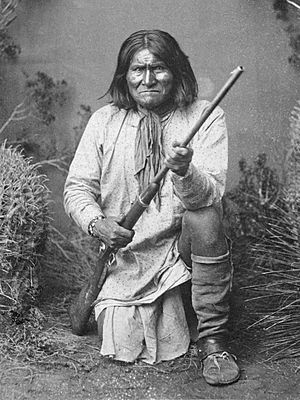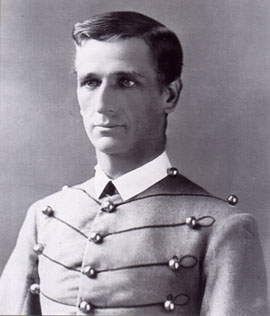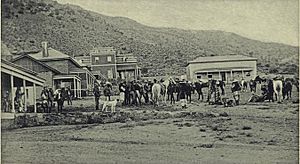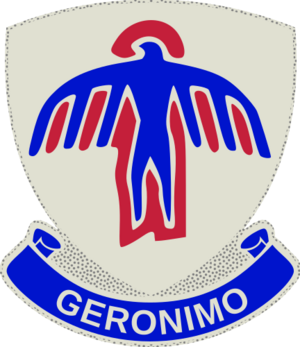Geronimo facts for kids
Quick facts for kids
Geronimo
|
|
|---|---|
| Goyaałé | |
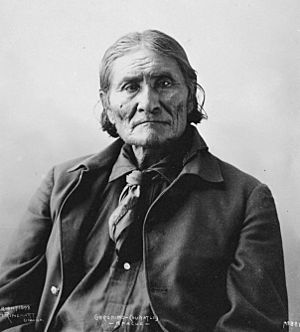
Photograph by Frank Rinehart, 1898
|
|
| Bedonkohe Apache leader | |
| Preceded by | Juh |
| Personal details | |
| Born | June 16, 1829 No-doyohn Cañon, Arizona |
| Died | February 17, 1909 (aged 79) Fort Sill, Oklahoma, U.S. |
| Resting place | Apache Indian Prisoner of War Cemetery, Fort Sill 34°41′49″N 98°22′13″W / 34.696814°N 98.370387°W, |
| Spouses | Alope, Ta-ayz-slath, Chee-hash-kish, Nana-tha-thtith, Zi-yeh, She-gha, Shtsha-she, Ih-tedda, and Azul |
| Children | Chappo, Dohn-say |
| Mother tongue | Apache, Spanish |
| Signature | |
|
Geronimo's chronology |
 |
Geronimo (whose Apache name was Goyaałé, meaning "the one who yawns") was a very important leader and medicine man of the Bedonkohe Apache people. He was born on June 16, 1829, and died on February 17, 1909.
From 1850 to 1886, Geronimo led many raids and fought against Mexican and U.S. soldiers. These battles took place in northern Mexico and the American Southwest. His actions were part of the long Apache Wars conflict. This conflict began when Americans moved onto Apache lands after the war with Mexico in 1848.
Apache people were used to moving freely, and they did not like living on reservations. They felt restricted and wanted to keep their traditional way of life. Geronimo often led groups of Apaches away from the reservations. He wanted them to return to their old nomadic lifestyle.
Even though he was famous, Geronimo was not a chief. He was a powerful shaman and a skilled leader in battles. He often led 30 to 50 Apache men in raids. In 1886, after a long chase, Geronimo surrendered for the last time. He and 27 other Apaches were sent to Florida as prisoners.
The United States government used Geronimo's fame. They displayed him at fairs and exhibitions. For example, he was at the Trans-Mississippi Exposition in 1898. He also rode in President Theodore Roosevelt's inauguration parade in 1905. Geronimo died in 1909 at Fort Sill, Oklahoma, still a prisoner of war. He was buried there with other Apache prisoners.
Contents
Who Were the Apache People?
The Apache is a name for several groups of Native Americans. They are culturally related and lived in the Southwest United States. These groups include the Western Apache, Chiricahua, Mescalero, Jicarilla, Lipan, and Plains Apache.
Apache raids on Mexican settlements started in the late 1600s. To stop these attacks, the Spanish built forts called presidios. Raiding became a part of the Apache way of life. It was used for both strategy and getting resources. Raids could involve stealing livestock or capturing people.
Mexicans and Americans often fought back. These retaliations were also violent. This led to a cycle of revenge between the Apaches and their enemies. Geronimo was especially driven by revenge. Mexican soldiers had killed his family. He became known for his fighting skills over 30 years.
Some Apaches had mixed feelings about Geronimo. They respected him as a strong leader in raids. But he was not always popular because he refused to give in to American demands. This made some Apaches fear what the Americans would do. Still, many Apaches were amazed by Geronimo's special powers. They believed he had supernatural gifts. He could sense distant events and predict the future. He also helped heal other Apaches.
Geronimo's Early Life
Geronimo was born near Turkey Creek in what is now New Mexico. This area was claimed by Mexico, but the Apache people did not agree. His grandfather, Mahko, was a chief of the Bedonkohe Apache. Geronimo had three brothers and four sisters.
His parents taught him Apache traditions. After his father died, his mother took him to live with the Tchihende Apache. When he was 17, Geronimo married a woman named Alope. She was from the Nedni-Chiricahua Apache band. They had three children together. Alope was the first of his nine wives.
The Attack at Janos
On March 5, 1851, a large group of 400 Mexican soldiers attacked Geronimo's camp. This happened near Janos, Mexico. The Apache men were in town trading at the time. Geronimo's wife, children, and mother were all killed in this attack.
This terrible loss made Geronimo hate all Mexicans for the rest of his life. He and his followers would often attack any Mexican groups they met. He felt a stronger dislike for Mexicans than for Americans.
Fighting the Mexican Army
Geronimo's chief, Mangas Coloradas, sent him to Cochise's group for help. Geronimo wanted revenge against the Mexicans. It was during this time that he got the name Geronimo. This name came from a battle where he bravely attacked Mexican soldiers with a knife. The soldiers supposedly called out to Saint Jerome ("¡Jerónimo!") for help.
Attacks and counter-attacks between Apaches and Mexicans were common. In 1860, miners attacked an Apache camp. They killed four Apaches and captured 13 women and children. The Apaches then raided American settlements in response.
In 1873, Mexicans attacked the Apache again. After much fighting, they agreed to a peace treaty. But after the Apaches were given alcohol, the Mexican troops attacked them. They killed 20 Apaches and captured others. The Apache were forced back into the mountains.
Geronimo was often outnumbered, but he fought bravely against both Mexican and U.S. troops. He became famous for his daring escapes from 1858 to 1886. One legend says he escaped from a cave in the Robledo Mountains. Soldiers waited outside, but Geronimo never came out. He was later seen nearby, having escaped through a hidden second entrance.
The Geronimo Campaign
The conflict between the Apache and the United States grew out of older wars with Mexico. Life on reservations was difficult for the Apache. They were used to moving freely, but now they faced diseases like malaria. The government provided food, but sometimes corrupt agents made it scarce.
Geronimo led his followers off the reservation three times. These "breakouts" happened in 1878, 1881, and 1885. Each time, they fled across Arizona and New Mexico into Mexico. They would raid and plunder as they went. They set up new bases in the rugged Sierra Madre Mountains.
In Mexico, they were safe from U.S. soldiers. The Apache knew the mountains well, which helped them hide. From Mexico, they would launch surprise raids back into the U.S. They often sought guns and ammunition. They moved quickly, attacking isolated ranches and travelers. They often killed everyone to avoid being discovered.
Both the Mexican and U.S. armies chased Geronimo's band. Mexico even allowed U.S. troops to enter their country to pursue the Apaches. In May 1885, Geronimo and other Apache leaders left the San Carlos Reservation. General George Crook sent troops into Mexico. These troops included Apache Scouts, who were very good at finding the hidden Apache camps. This was unsettling for Geronimo's band, as their own people were helping the enemy.
The constant pursuit by both Mexican and American forces wore down Geronimo and his followers. They had little time to rest. This constant pressure eventually led to their surrender.
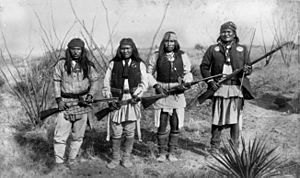
In January 1886, Captain Emmet Crawford found Geronimo's band. His Apache Scouts attacked and captured their horses. The Apaches were tired and agreed to talk about surrendering. Before they could finish, Mexican troops arrived. They mistook the Apache Scouts for the enemy and attacked, killing Captain Crawford.
Lt. Maus then met with Geronimo, who agreed to meet General Crook. The meeting took place in the Cañon de los Embudos in Mexico. During the negotiations in March 1886, photographer C. S. Fly took pictures of the Apache. These are the only known photos of Geronimo's surrender. They are also the only known photos of an American Indian still at war with the United States.
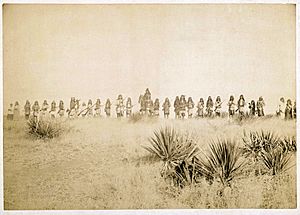
Geronimo agreed to Crook's surrender terms. But that night, a soldier told them they would be killed if they crossed the border. Geronimo and 39 followers slipped away. General Crook was then replaced by General Nelson A. Miles.
General Miles sent Captain Henry Lawton and Lieutenant Charles B. Gatewood to find Geronimo. Gatewood was known to Geronimo and spoke some Apache. Lawton's constant pursuit wore down the Apaches. Completely exhausted, Geronimo and his small group returned to the U.S. They officially surrendered to General Miles on September 4, 1886.
When Geronimo surrendered, he had a Winchester rifle, a Colt revolver, and a Bowie knife. These items are now on display in museums. There is still debate about whether Geronimo's surrender was truly unconditional. He always said he was misled.
At the end of his fighting career, Geronimo led only 38 men, women, and children. They avoided thousands of Mexican and American troops for over a year. This made him the most famous Native American of his time. His band was one of the last groups of independent Native American warriors. They refused to accept the United States taking over the American West.
Life as a Prisoner of War

Geronimo and other Apaches were sent as prisoners to Fort Sam Houston in Texas. Then they were moved to Fort Pickens in Florida. His family was sent to Fort Marion in Florida. This quick action stopped Arizona authorities from trying Geronimo for deaths during his raids.
In Florida, many Apaches died from diseases. Businessmen saw Geronimo as a tourist attraction. Hundreds of visitors came to see the "bloodthirsty" Indian in his cell. While they were prisoners, the government moved hundreds of Apache children from Arizona to a school in Pennsylvania. Many of these children died from tuberculosis.
In 1888, the Chiricahuas moved to Mt. Vernon Barracks in Alabama. They were reunited with their families there. But a quarter of them died from tuberculosis. So, in 1894, Geronimo and the Chiricahuas were moved to Fort Sill, Oklahoma. They built villages and started farming. On the train ride to Fort Sill, tourists paid Geronimo for buttons from his shirt or hats he wore. He would buy more to sell along the way.
In 1898, Geronimo went to the Trans-Mississippi International Exposition in Nebraska. He became a major attraction because of newspaper stories about the Apache Wars. This made him a celebrity. For the rest of his life, he was in demand for fairs. He went to the Pan-American Exposition in 1901 and the St. Louis World’s Fair in 1904. Under Army guard, Geronimo dressed in traditional clothes, posed for photos, and sold his crafts.
He also joined Pawnee Bill’s Wild West shows. The shows showed Indians as "savage" monsters who had been "tamed." Visitors paid Geronimo for a button from his coat. These shows earned him money and allowed him to travel, always with guards.
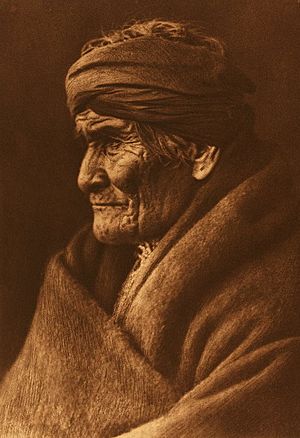
In 1905, Geronimo rode a horse in President Theodore Roosevelt's Inaugural Parade. He rode with five other Indian chiefs. This showed Americans that they had "buried the hatchet." Later, Geronimo met with Roosevelt. He asked for his people at Fort Sill to be freed and allowed to return to Arizona. President Roosevelt refused. He mentioned the anger in Arizona over the deaths caused by Geronimo's raids. Roosevelt told Geronimo that he had a "bad heart" for killing many people and burning villages.
In 1905, Geronimo told his life story to S. M. Barrett. Barrett was a Superintendent of Education in Oklahoma. Geronimo knew exactly what he wanted to say in each interview. He spoke in Spanish, and his story was translated into English.
Geronimo's Family and Beliefs
Geronimo married Chee-hash-kish and they had two children, Chappo and Dohn-say. He later married Nana-tha-thtith and had another child. He also had wives named Zi-yeh, She-gha, Shtsha-she, Ih-tedda, and Azul. Azul was his ninth and last wife.
Geronimo's great-great-grandson, Harlyn Geronimo, taught the Apache language. He lived on the Mescalero Apache Reservation until he passed away in 2020.
Geronimo grew up following the traditional religion of his Bedonkohe people. In 1903, he joined the Dutch Reformed Church. However, he was removed from the church four years later for gambling. Even near the end of his life, he seemed to have mixed feelings about religion. He told Christian missionaries he wanted to start over, but also told his tribesmen he still believed in the old Apache religion.
Geronimo's Legacy
Paratroopers
Inspired by a 1939 movie called Geronimo, U.S. Army paratroopers started a tradition. When they jumped out of planes, they would shout "Geronimo!" This showed they were not afraid. Other Native American traditions were also used in World War II. These included "Mohawk" haircuts and face paint. The 1/509th PIR paratrooper unit at Fort Polk, LA, uses Geronimo as their nickname.
Code Name
The United States military used the code name "Geronimo" for the raid that killed Al-Qaeda terrorist Osama bin Laden in 2011. However, this use of the name angered some American Indians. The operation was later reported to be named "Operation Neptune Spear."
Commemorations
Three towns in the U.S. are named after Geronimo. They are in Arizona, Oklahoma, and Texas. A World War II Liberty ship, the SS Geronimo, was also named after him. The U.S. Postal Service issued a 29¢ postage stamp showing Geronimo on October 18, 1994.
Images for kids
See also
 In Spanish: Gerónimo para niños
In Spanish: Gerónimo para niños


